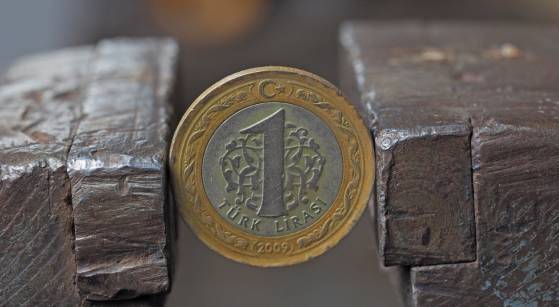With another higher than expected monthly turnout, the current account deficit showed a further widening in March, driven by higher energy bills. It stood at US$24.2bn on a 12-month rolling basis

People walking on the famous Istiklal Street, Istanbul
Turkey's current account balance maintained its rapid deterioration in March with another higher than expected monthly deficit at USD-5.6bn. The 12M rolling current account is also rising with USD-24.2bn (translating into c. 3.4% of GDP). A quick glance at the February data shows that rising external imbalances are mainly attributable to the uptrend in energy prices weighing on energy imports, despite continuing rapid growth in tourism revenues as the impact of Russia & Ukraine war seems to be offset by the rise in the share of foreign visitors from the MENA region and Europe.
Breakdown of Current Account
12M Rolling, US$bn

Source: CBT, ING
The capital account turned to be slightly negative at US$-0.5bn, driven by resident outflows. With the C/A deficit and relatively high net errors & omissions at US$1.6bn, reserves recorded a USD4.5bn decline.
In the breakdown of monthly flows, residents increased their external assets by USD4.6bn, mainly attributable to rising deposits of local banks abroad and the impact of residents’ portfolio investments. For non-residents, we saw USD4.1bn inflows, being short of the outflows on the resident side. Non-resident moves were mainly attributable to debt creating flows, namely i) USD1.4bn trade credits ii) USD1.8bn deposits placed by foreign investors to Turkish banks and iii) USD1.7bn net borrowing thanks to USD0.7bn secured by the general government and US$0.8bn long-term borrowing of the corporate sector.
Accordingly, we saw an improvement in the long-term debt rollover rate for corporates to 177%
(a strong 142% on a 12M rolling basis), while the same ratio for banks stood at 77% (89% on a 12M rolling basis) with a net USD0.5bn net repayments slightly above that of net short-term borrowing. On the flip side, among non-debt creating flows, USD0.7bn gross FDI was broadly aligned with outflows from the equity market.
Breakdown of Financing
12M Rolling, US$bn

Source: CBT, ING
Overall, the current account deficit has remained on an expansionary path in March, driven by commodity imports and particularly higher energy bills. As oil prices are expected to remain elevated, the current account will likely maintain the widening trend in the near term. The outlook for the whole year will be determined by tourism revenues and energy prices given the uncertainty, while signals of a slowdown in economic activity hint that core imports can weaken in the period ahead.
On the financing side, the global backdrop turning less supportive should also add challenges given high external financing requirements as well as heavy reliance on financial flows rather than long-term finance like FDI, which is low relative to peer countries.
Tags
Turkey Tourism Reserves Current Account Capital account
Disclaimer
This publication has been prepared by ING solely for information purposes irrespective of a particular user's means, financial situation or investment objectives. The information does not constitute investment recommendation, and nor is it investment, legal or tax advice or an offer or solicitation to purchase or sell any financial instrument. Read more











![Warsaw Stock Exchange: Brand24 (B24) - 1Q23 financial results Turbulent Q2'23 Results for [Company Name]: Strong Exports Offset Domestic Challenges](/uploads/articles/2022-FXMAG-COM/GPWA/gpw-s-analytical-coverage-support-programme-wse-2-6311cd4191809-2022-09-02-11-30-41-63175bda84812-2022-09-06-16-40-26.png)









![Warsaw Stock Exchange: Brand24 (B24) - 1Q23 financial results Turbulent Q2'23 Results for [Company Name]: Strong Exports Offset Domestic Challenges](https://www.fxmag.com/media/cache/article_small_filter/uploads/articles/2022-FXMAG-COM/GPWA/gpw-s-analytical-coverage-support-programme-wse-2-6311cd4191809-2022-09-02-11-30-41-63175bda84812-2022-09-06-16-40-26.png)


